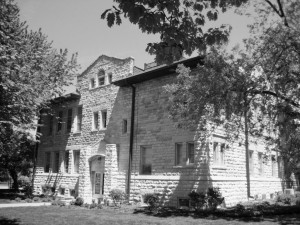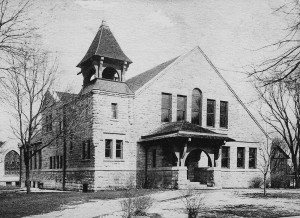In 1974, the Grand Avenue School had been completely renovated. But, just a few years later, school enrollment declined, making the building’s long-term survival very bleak.

Grand Avenue Community Center – 2014
Built in 1885, the Grand Avenue School building is actually older than our town’s historic Water Tower. For many years, it was the village’s only elementary school. However, as the population grew, four more schools were built. By 1980, enrollments were declining and the School Board decided it had to close two of its five schools. In 1981, after a lengthy study, the Board vote to close the two oldest buildings, Clark School at Franklin and 46th Street, and the Grand Avenue School at Walnut and Grand.
Despite this, the School Board agreed to rent out space in Grand Avenue School to the village’s Recreation Department, the Historical Society, and independent contractors offering daycare, dance, and music instruction. As the demand for these programs grew, the village decided to lease the larger Franklin Avenue School for use as a Recreation Center. Gradually, all of the tenants left the Grand Avenue building, leaving its future uncertain at best.
In 1983, grassroots efforts were undertaken to protect the building from demolition by securing Landmark status. However, because of the extensive renovations and additions that had been made over the years, the building did not meet the requirements. But, during this period, a village-wide survey showed that 85% of the citizens favored saving the building. Sadly, given its budget constraints, the School Board was still inclined to sell the property.
At a February 1984 School Board meeting, Bob Kemper gave an eloquent speech in which he and other key residents sought additional time to develop an alternative to selling the school. To its credit, the School Board agreed and appointed a task force to study alternative uses. Soon, the Western Springs Community Center Association (WSCCA) was formed and, under the guidance of Charles Neal and others, it began an endless series of meetings. Some people favored limited development of the building and land. Others wanted youth space, senior citizen housing, ballet space, or a cultural center. The only thing these groups had in common was a recognition of the building’s historical significance.

Grand Avenue School – circa 1890
In March 1984, the Historical Society pledged $20,000 toward saving the building. Soon after, the Park District agreed to fund the purchase of several lots adjoining the building. The Thomas Ford Library followed suit, acquiring some of the land for parking lot construction. And, private citizens began making donations. A benefit performance was held at the Theatre of Western Springs and a huge Craft Show was held as well. Even a half-hour video was produced featuring radio personality and resident Steve Dahl.
Despite all of this public support and contributions, the sale of the building would require more Village government involvement. So, the trustees placed a referendum on the ballot to measure resident support. The vote tally showed a 3-to-1 margin in favor of the project. After numerous negotiations, bond sales, and other machinations, the building was saved. And, eventually, the village purchased the building from the WSCCA and assumed responsibility for its on-going maintenance. But, had it not been for a group of dedicated citizens and officials, this one-of-a-kind community center would have likely been re-developed into more housing units.
